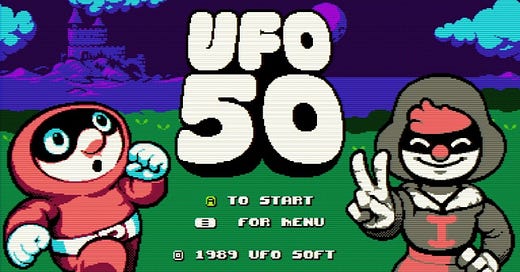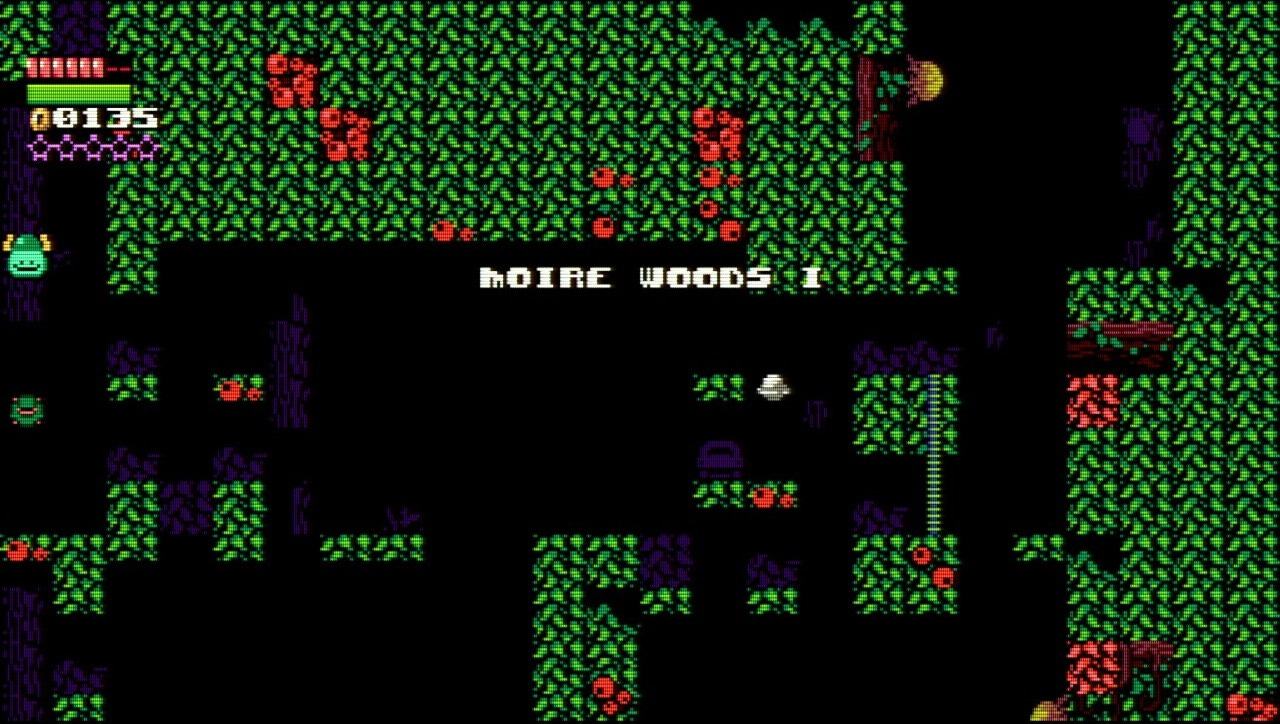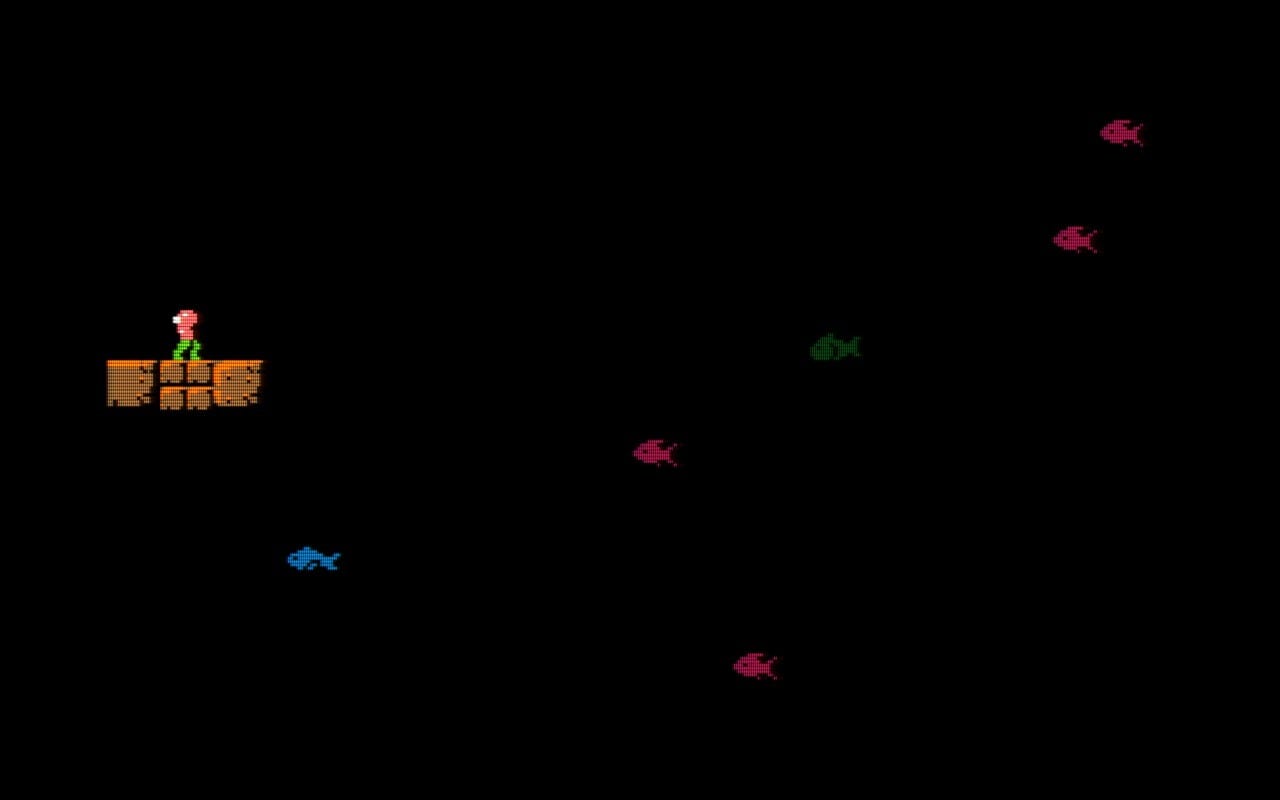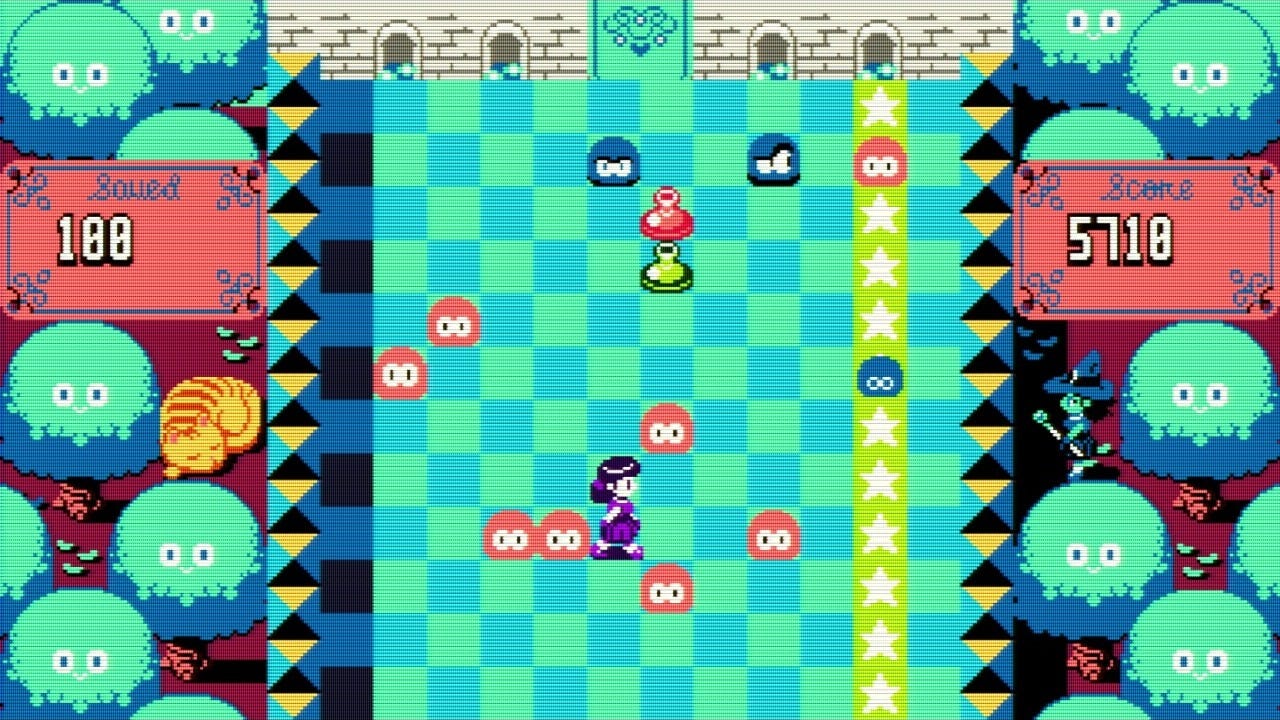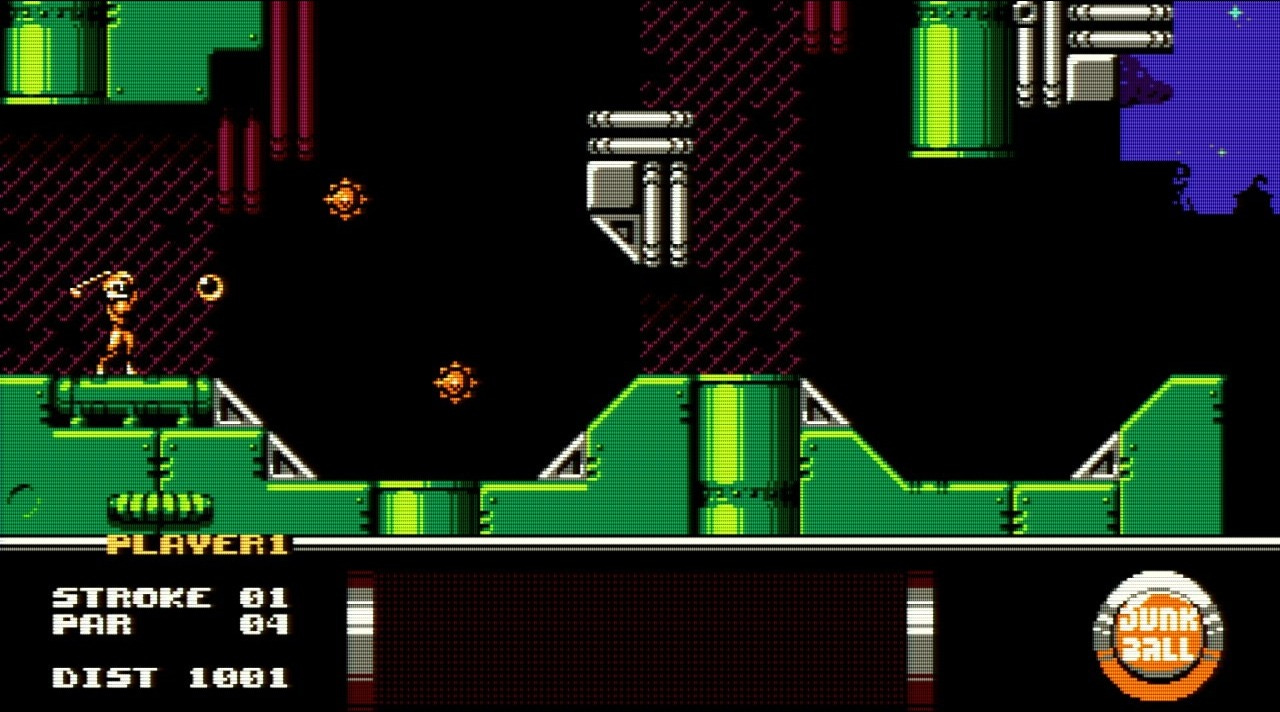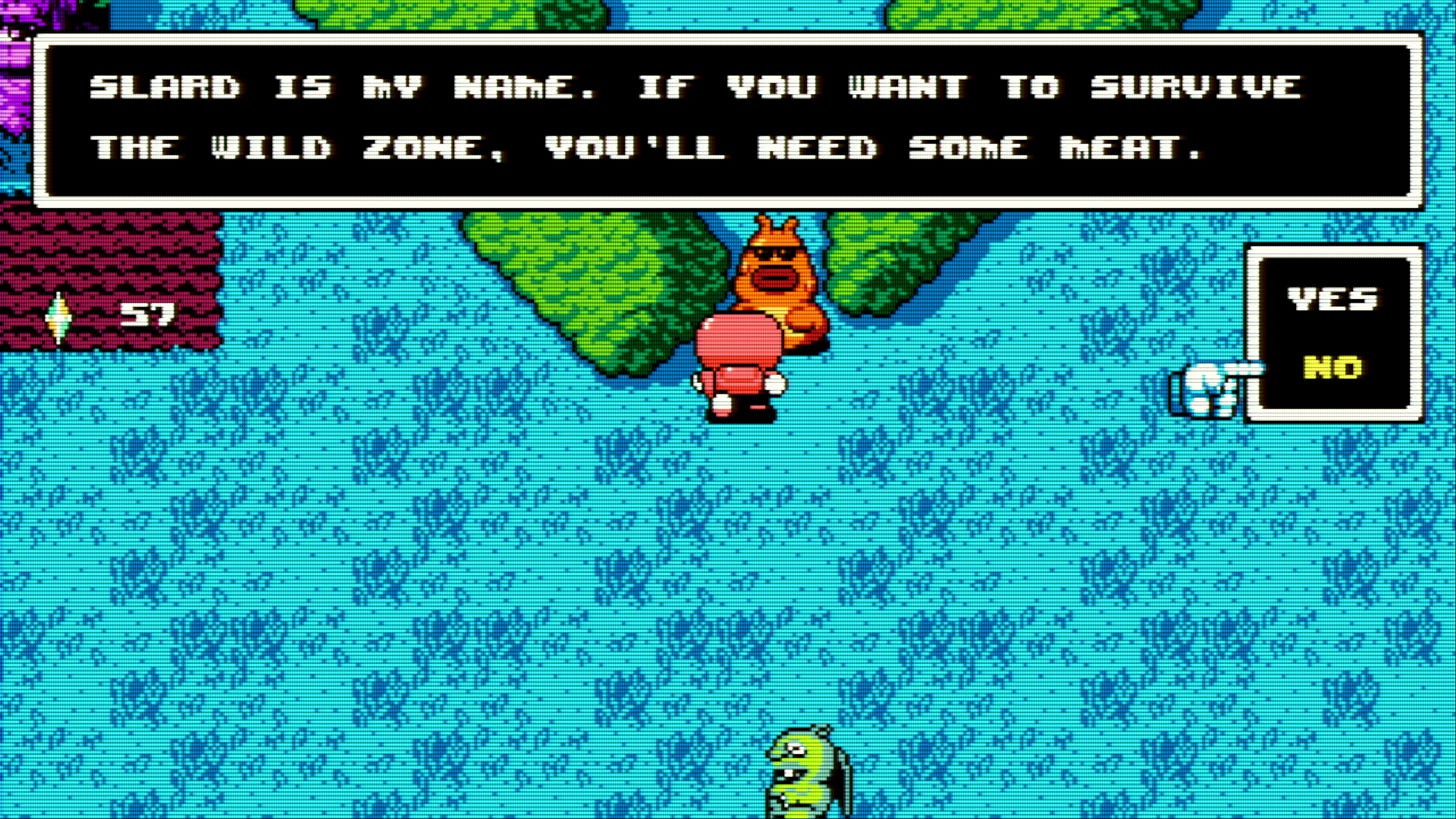UFO 50 was reviewed based on a pre-release copy provided by the publisher, Mossmouth. no money was exchanged, and all opinions are my own. thanks, Mossmouth!
UFO 50 is impossible to review as a single game. not only is it a collection of 50 complete titles that offer 50 entirely distinct experiences, but it’s also, miraculously, more than the sum of its many, many parts.
that’s why i’ve decided to split this bug quest into two parts. if you missed part one, that’s the one where i discussed my fascination with UFO 50’s anthological structure and subtle, unexpectedly compassionate storytelling. in this second part, i’ll get into some of the actual games collected in this gargantuan package.
i want to be clear here: even across two separate parts, i don’t think i’ve written a comprehensive review of UFO 50. there’s so much going on, both in the actual games and in the way they’re presented to the player, that i could write a hundred bug quests and i sincerely believe i’d still find new things to say about UFO 50 in every single one of them. so instead of trying to dig into every detail about every game here, i’m just going to take a representative sample of some of my very favorites.
if you want to learn about all 50 games, i’d suggest picking up a copy of UFO 50 and playing through them for yourself. it’s worth it.
Campanella 2
one of UFO 50’s most impressive magic tricks is its ability to make you feel like a long-time fan of a game that you’ve only known about for a few hours. there are a few mini-franchises in UFO 50 that take advantage of that manufactured feeling of fandom, but my absolute favorite is the “Campanella” series.
the first game in UFO Soft’s fictional flagship franchise, “Campanella,” is a precision platformer about moving a spaceship through single screen levels with an easy-to-learn-tough-to-master momentum-based movement system. i like “Campanella” a lot. it’s one of my most played games in UFO 50 and it would certainly earn a place on a longer list of personal favorites.
moment to moment, “Campanella 2” feels a lot like that first game, but it also introduces a laundry list of new ideas that change the tone completely. first of all, those single screen levels are gone, replaced by wide open randomly generated environments littered with tight corridors. there’s also a whole new system for getting out of your spaceship and exploring hidden caverns on foot. between those two massive shifts to the formula and a few smaller ones, like an increased focus on fuel scarcity, “Campanella 2” feels like a wholly different, more adventurous, more dangerous experience, but one that maintains the series’ identity.
in short, it’s a perfect sequel.
seeing the dramatic changes made to the “Campanella” formula is rewarding to me, not because i can imagine how it would feel to be a “Campanella” fan, but because i am a “Campanella” fan. by the time i played “Campanella 2,” i already really enjoyed the first game. seeing “Campanella” go from a level-based precision platformer to a proc-gen open world adventure game is exciting in the same way that playing a Mario RPG is existing.
if you’re coming to UFO 50 as a fan of co-creator Derek Yu’s fantastic Spelunky series, then “Campanella 2” should actually look pretty familiar to you. but i wasn’t even thinking about Spelunky when i was playing this one - i was just excited to see a new take on “Campanella.” a game i played two hours earlier.
Mooncat
in an effort to cram 50 games into a single package without making any one of them feel redundant, UFO 50’s developers seem to have taken a good hard look at all the bits and pieces of video games that we take for granted. 2D platformers, for example, are games where you move using the d-pad and jump using the face buttons. not so in “Mooncat.”
i won’t spoil exactly how “Mooncat” controls - cracking that particular code is half the fun - but i will say that a new control scheme completely changed my relationship with the idea of a platformer.
“Mooncat” has a fantastic multiplayer mode that lends it an awful lot of replayability. once you’ve familiarized yourself with the controls, it’s a lot of fun to watch someone else puzzle over them while you dash around the screen like a madman.
a novel movement system isn’t all “Mooncat” has going for it. you’ll also find some of the coolest vibes of all time in this one. i’m a huge fan of the dreamy look and feel of the whole thing, and i’ve gone back to it several times just to listen to the music in some of the earlier sections.
this is also an easy game to point to when discussing UFO 50’s incredible scale. “Mooncat” is one of the only UFO 50 games i’ve rolled credits on (more than once now) but i’m still replaying the game and finding secrets with some regularity.
Magic Garden
explaining the appeal of “Magic Garden” feels a bit like explaining the appeal of a glass of water. it’s Snake by way of Pac-Man with adorable art and an earworm-y chiptune soundtrack. if that doesn’t sound good to you, you might be an agent of the actual devil.
i don’t have a whole lot more to say about this one - it’s an excellent arcade game, much more interesting to play than to opine on - so i’ll just note that i literally played “Magic Garden” until my fingers hurt, and i kept playing after that.
Pingolf
“Pingolf’s” inclusion on this list is, i’ll admit, a little backhanded. “Pingolf” is one of my favorite games in UFO 50, but it’s also the only game in the whole anthology that feels a little hampered by its inclusion.
a super-simple arcade golf game that involves dunking your golf ball from mid-air, “Pingolf” feels like it should be the perfect party game. it’s easy to pick up, and playing it casually doesn’t take too much brainpower, but every hole is designed with an aggravating precision that allows for lots of those perfect party game rage moments. it’s so fun to clown on a buddy for missing the same seemingly easy putt ten times in a row… until it’s your turn and you blow it in the exact same way twenty times.
unfortunately, “Pingolf” is one of the few games in UFO 50 that really feels like it could use a few more minutes in the oven. there aren’t many courses, and the ones that are there can only be played in a single linear competition that overstays its welcome by just a bit. most frustratingly, “Pingolf” only supports up to two players.
“Pingolf” is so fantastic and so close to being a hall of fame arcade-sports-party game that i kept expecting to find a sequel somewhere in UFO 50. unfortunately, there isn’t one. but there totally should be!
in part one, i praised UFO 50 for its steadfast commitment to its fiction, even when it means a couple of the games come up just short of perfection. i still find that admirable, and i do truly believe that “Pingolf’s” individual shortcomings make for a stronger, more textured, more compelling complete collection. i just wish i could play an expanded standalone “Pingolf” release. put that on Steam and i’ll be all over it. i love “Pingolf.”
Camouflage
in some ways, “Camouflage” might be UFO 50’s best party game. this is a single-player stealth puzzle game about a little lizard who changes colors to avoid enemies. if that sounds like a fun game to play on your own, good news: it is! that being said… i could not finish more than two levels until i sat down with a couple of friends.
every single-player puzzle game is secretly better with buds, but if you are a little bit of a puzzle bozo like me, then “Camouflage” is a particularly entertaining time with a few extra brains. not only is it fiendishly difficult, but it’s also entirely space-based, which means everyone on the sofa will inevitably wind up pointing at the screen and shouting over each other, trying to explain how you can stay blue if you hug the western wall and hide behind that rock.
once you and your pals finally manage to master the space and sneak past every unsuspecting predator on the screen, i can promise with certainty that you will feel like a genius. “Camouflage” really does demand a shocking amount of brainpower, and solving its many puzzles is extremely rewarding.
there’s a lot more to “Camouflage” - if you’re feeling up to the challenge, for example, you can try to rescue a smaller lizard hiding in every level, whose similar color-changing capabilities double the difficulty.
“Camouflage” is a fantastic puzzle game. i’d even say that it single-handedly justifies UFO 50 for any puzzle freaks with a few friends.
Pilot Quest
if “Pingolf” can occasionally feel like an argument against UFO 50’s anthological structure, “Pilot Quest” is the perfect argument in its favor. one of several “Campanella” spinoffs, “Pilot Quest” is equal parts Zelda-style action-adventure game and AdVenture Capitalist-esque idle game.
one half of the game is all about collecting resources. there’s a big old crystal in the center of your home base that you can hit over and over again to collect shards, which you can spend on upgrades that passively produce shards for you. from there, “Pilot Quest” spirals out into a fairly standard idle game about converting currencies and upgrading production pipelines.
things get interesting when you unlock Meat. you need Meat to enter the Wild Zone, an expansive, interconnected map full of enemies, friends, and new resources. Meat is converted into time in the Wild Zone, and being hit by an enemy means losing a bit of time. if you run out of time before you make it back to your home base, you’ll lose everything you’ve collected.
this two-tiered design makes “Pilot Quest” an excellent addition to a huge collection of games. the idle production carries on in the background when you aren’t playing, so if you get stuck on a particularly difficult bit of a different game, you can always return to “Pilot Quest” for a quick guaranteed dopamine hit. on the other hand, if you really want to spend some time on “Pilot Quest,” you’re invited to engage with it as a much more active, much more tense experience.
“Pilot Quest” is a nice long-term game to check in on every so often while working through the rest of UFO 50, but it’s also a rewarding game to really sink your teeth into. “Pilot Quest” displays all of UFO 50’s greatest strengths at once.
And many, many more.
like i said before, this is far from a comprehensive review of UFO 50. i don’t know if a comprehensive review of UFO 50 is even possible. touching on just six of 50 games feels inadequate - the other 44 are just as interesting - but talking about UFO 50 in the first place feels a little inadequate.
after about 30 hours with UFO 50, i still feel like i’ve barely scratched the surface. in fact, after writing two full bug quests in just under a week, all i want to do is play more UFO 50.
i love talking about this game. i love talking about it so much that i simply can’t stop trying to explain it to you, my lovely readers. but talking about UFO 50 doesn’t begin to communicate its impact.
i know i’m prone to hyperbole and excessive praise when i really love something, but i need to drive home just how special this one is. you won’t understand it by reading about it. UFO 50 demands to be experienced.

